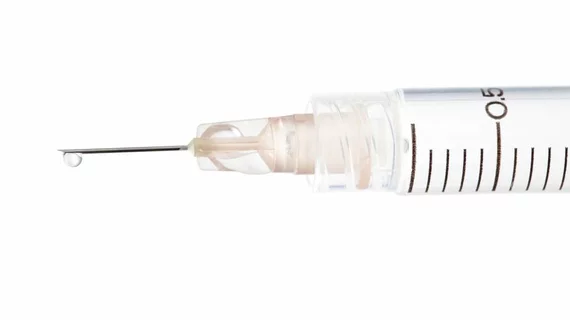A possible shortage of heparin, one of the most popular blood thinners on the market, is threatening the U.S., according to a viewpoint published in The Lancet on Jan. 23.
Rumors of a heparin shortage first surfaced in late 2019, after drugmakers Pfizer, Hospira and Baxter International reported deficits in their supply, Cian P. McCarthy, MD, a cardiology fellow at Massachusetts General, and colleagues wrote in the journal. All three companies attributed their shortages to manufacturing disruptions, but an outbreak of African swine fever in China in August 2018 pushed the issue further.
Heparins are the most widely used parenteral anticoagulants today, considered integral to cardiopulmonary bypass, extracorporeal member oxygenation and venous thromboembolism. But heparin derived from swine is the most common—and only—form of the blood thinner used in the U.S., and African swine fever is threatening to wipe out a quarter of the world’s pigs.
In their viewpoint, McCarthy and co-authors outlined our history with heparin and several steps we can take to ensure our global supply isn’t depleted. The following are six things to know about the situation:
1. We rely on China for our heparin.
Heparin was first discovered in 1916, McCarthy et al. said, and by 2000 some 12 million patients were receiving heparin products in the U.S. alone. Heparin can be sourced from cattle, sheep and turkeys—the first heparin product approved by the FDA was actually extracted from cows—but after an outbreak of bovine disease in the 90s, the U.S. made a shift to pig-derived heparin.
China is the world’s largest producer of swine, so it makes sense that it also manufactures around 80% of the world’s heparin. The recent outbreak of African swine fever has killed more than one-third of the country’s pigs, threatening the more than 30 trillion international units of heparin that are produced in China each year.
2. Heparin exists in two forms…
Heparin is either manufactured as unfractionated heparin (UFH), a mixture of different chain lengths of a glycosaminoglycan, or low-molecular weight heparins (LMWHs). The UFH mixture ranges in weight from 5,000 to 30,000 daltons; LMWHs are isolated from UFH by depolymerization, ultimately producing chains with a weight of 8,000 daltons or less.
Multiple LMWH strands can be produced from a single UFH molecule, McCarthy et al. explained, meaning a smaller amount of raw heparin is required to make LMWHs. Because of that, LMWH stocks are currently preserved, but the authors said that could easily change as we deplete UFH stocks and LMWH use increases.
3. ...But they can’t be used interchangeably.
Alternatives for UFH do exist in some clinical scenarios, the authors wrote, but there are certain situations that would suffer more from a heparin shortage. For instance, UFH is the anticoagulant of choice for cardiopulmonary bypass surgery and percutaneous ventricular support systems—scenarios in which LMWHs couldn’t be substituted for UFH because there’s not enough evidence backing their efficacy or safety. Other blood-thinning alternatives, like bivalirudin and argatroban, are costly.
“A severe heparin shortage would have substantial implications for patient care, especially in situations in which heparin is standard of care and alternative anticoagulants have inadequate evidentiary support or might be harmful,” McCarthy and co-authors wrote.
4. This has happened before.
An outbreak of blue-ear pig disease, a respiratory disease, in Asia in 2007 resulted in “considerable shortages” of heparin, the authors wrote, and one year later a major scandal emerged when heparin products originating from China were found to be contaminated with oversulfated chondroitin sulphate. Several hundred people were injured and 81 died in the U.S. from anaphylactic-like reactions to the tainted heparin.
“A decade later, history is unfortunately repeating itself,” McCarthy et al. said.
The 2008 heparin shortage impacted only heparin vials for injection and a handful of heparin-coated medical devices; the authors said products were available from different manufacturers and the U.S. was never at risk of completely running out
5. It’s not slowing down.
Unlike in 2008, the potential heparin shortage of today doesn’t show any signs of slowing down. It’s estimated that up to 30-40% of pigs in China have died from African swine fever, and reports show deaths are ongoing with no evidence that viral transmission of the disease has curtailed.
Last summer, Fresenius Kabi, a German heparin manufacturer, started rationing shipments of heparin to its U.S. customers. In October, the FDA reported the outbreak of swine fever in China hadn’t affected the manufacturing or distribution of heparin in the U.S., but several institutions have begun preparing for the possibility.
6. There are steps we can take to curb the shortage.
To avoid the potential shortage, McCarthy et al. suggest clinicians start prioritizing heparin for certain patients and situations. They said heparin should be reserved for patients with the greatest need for it, like pregnant women receiving long-term anticoagulation and cancer patients being treated for venous thromboembolism.
The authors wrote that if the heparin shortage were to progress to a critical status, physicians might think about prioritizing UFH for only urgent or emergent cardiac surgeries. They said hospital leaders should implement action plans to address the shortage, noting that at MGH leadership has introduced a venous thromboembolism prophylaxis pathway that’s resulted in an 84% reduction in heparin use.
Lastly, global manufacturers might think about broadening their suppliers to regions unaffected by the swine virus.
“Manufacturing disturbances and an outbreak of African swine fever in China are threatening to cause a severe heparin shortage globally, particularly in the U.S.A., which currently relies solely on porcine-derived heparin,” the team wrote. “Such a severe shortage could have a detrimental effect on patient care, and therefore physicians, hospital administrators, manufacturers, regulators and the community at large should prepare for alternative anticoagulant strategies and secure safe and more durable long-term anticoagulant options.”

